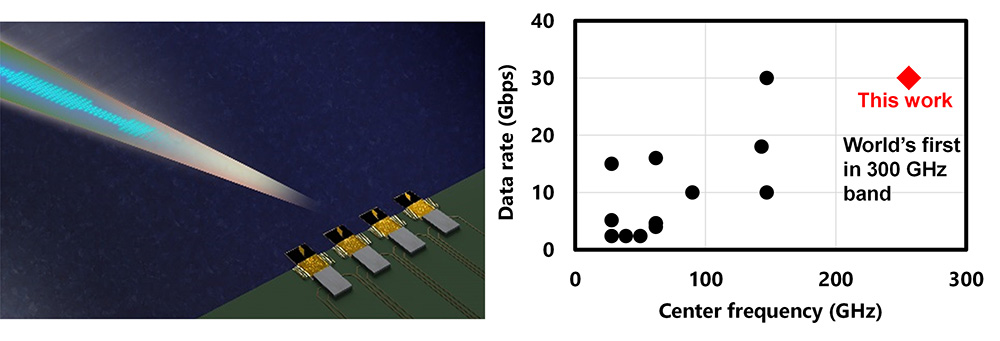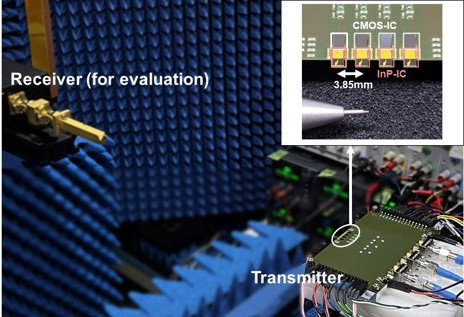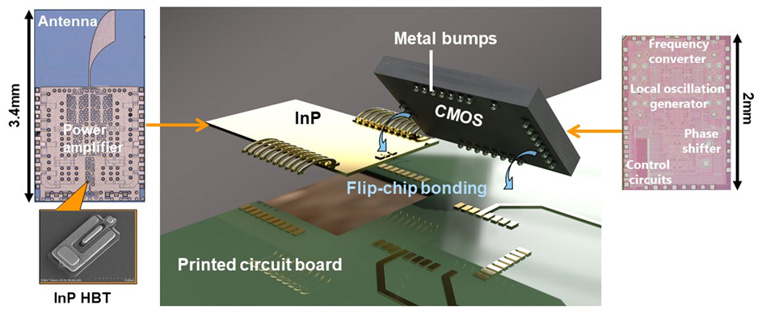News: Microelectronics
19 July 2023
NTT achieves 300GHz-band high-speed data transmission with beamforming
At June’s 2023 IEEE MTT-S International Microwave Symposium (IMS) in San Diego, CA, USA, Tokyo-based NTT Corp and researchers at the Tokyo Institute of Technology said that they have demonstrated a phased-array transmitter module to enable instantaneous ultra-high-capacity data transmission to mobile receivers. The researchers achieved the first wireless data transmission via beamforming in the 300GHz band, which is expected to be utilized in the realization of sixth-generation (6G) communications.
Research background
In 6G wireless communications systems, ultra-high-speed wireless communications are expected to be achieved by utilizing the 300GHz band, which has the advantage of being able to use a wide frequency range. On the other hand, it faces the problem of large path loss during signal propagation through space. Beamforming technology is being studied to overcome this problem.
Beamforming concentrates and directs radio energy toward the receiving device. In 5G wireless systems that use radio waves in the 28GHz and 39GHz bands, beamforming has been realized with CMOS integrated circuits. On the other hand, CMOS ICs alone lack sufficient output power in the 300GHz band. Combining CMOS ICs with III-V compound semiconductor ICs, capable of high output power, is therefore being attempted around the world to achieve beamforming in the 300GHz band. However, because high output power is prevented by the large energy loss occurring inside the III-V IC and in the connection between the III-V IC and the CMOS IC, high-speed wireless data transmission by beamforming has not been achieved until now.
Research results
NTT has developed indium phosphide (InP) ICs that integrate its proprietary high-output power amplifier circuit and antenna circuit. This is enabled by NTT’s proprietary InP-based heterojunction bipolar transistor (InP HBT) technology. Tokyo Tech has succeeded in fabricating a highly scaled CMOS IC containing frequency conversion and control circuits. NTT and Tokyo Tech have now developed a compact four-element phased-array transmitter module by mounting the CMOS IC and InP IC on the same printed circuit board. With a steering range of 36°, maximum data rate of 30Gbps and communication distance of 50cm, this transmitter module has achieved the first high-speed wireless data transmission in the 300GHz band using beamforming (Figure 1).

Figure 1: (Left) Beamforming using phased-array wireless device. (Right) Comparison of previously reported transmission with beamforming wireless devices and this achievement.
Key technical points
The following two technologies made the beamforming and high-speed wireless data transmission possible.
1. Design of 300GHz-band high-output power amplifier circuit
NTT and Tokyo Tech have designed a power amplifier circuit that achieves high output power in the 300GHz band and realized its fabrication by using NTT’s proprietary InP HBT technology. For the power amplifier circuit, high output power is achieved by combining electrical power output from multiple amplifier elements using a low-loss power combiner. The circuit amplifies the signals output from the CMOS IC and radiates the radio wave to the receiving device from the antenna packaged on the same chip. NTT and Tokyo Tech’s achievement enables the delivery of high output power to the receiving device, which is needed for high-speed data transmission (Figure 2).

Figure 2: The newly developed 300GHz-band phased-array transmitter and the transmission experiment.
2. High-frequency band low-loss mounting technology
Conventionally, to connect different types of ICs for the 300GHz band, each IC is mounted on a waveguide module, and the modules are connected together. However, this approach has the problem of energy loss when radio waves pass through the waveguides. NTT and Tokyo Tech’s achievement is said to overcome this problem through flip-chip bonding of the CMOS IC and the InP IC and connecting them using metal bumps of several tens of microns in size. This packaging approach reduces connection loss and achieves high output power
(Figure 3).

Figure 3: Exploded-view diagram of 300GHz band phased-array transmitter and photo of the chip.
Future research
Short-distance mobile communication devices are expected to be deployed in 6G networks in the future. NTT and Tokyo Tech’s technology promises to expand these applications, such as interactive kiosks and femtocells. The developed technology demonstrated one-dimensional beamforming. NTT and Tokyo Tech are working on demonstrating two-dimensional beamforming with a 2D array and extending the communication distance by increasing the number of arrays. NTT and Tokyo Tech are also engaged in the development of receiver modules to meet the needs of 6G applications, and in the practical implementation of wireless communication with transmission capacity ten-fold greater than is available currently.








